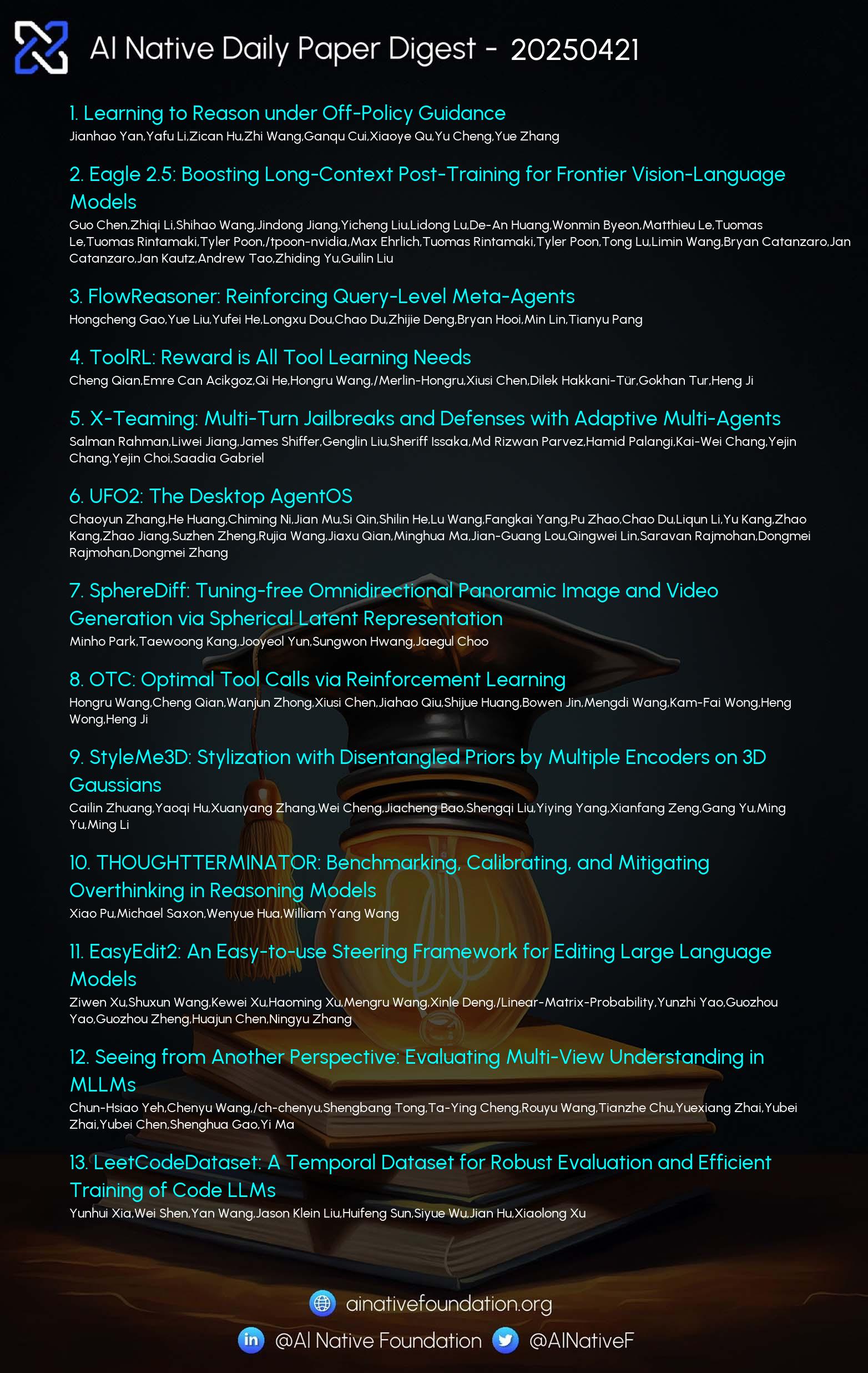AI Native Daily Paper Digest – 20250422
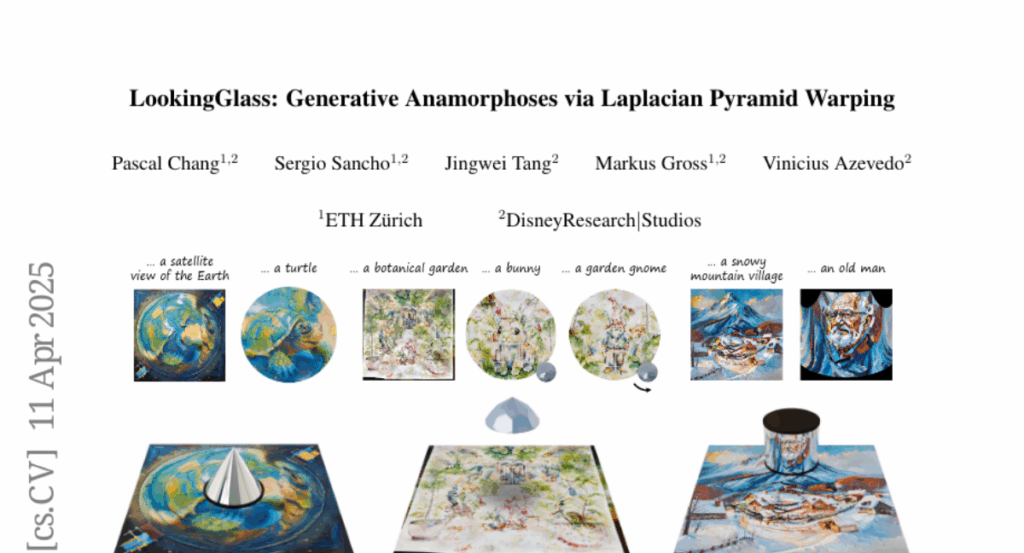
1. Learning to Reason under Off-Policy Guidance
🔑 Keywords: Large Reasoning Models (LRMs), Reinforcement Learning (RL), Zero-RL, Off-Policy, LUFFY
💡 Category: Reinforcement Learning
🌟 Research Objective:
– This paper introduces LUFFY, a framework aiming to enhance zero-RL approaches by integrating off-policy reasoning traces to overcome limitations of on-policy learning.
🛠️ Research Methods:
– LUFFY dynamically mixes off-policy demonstrations with on-policy rollouts. It employs policy shaping through regularized importance sampling to balance imitation and exploration effectively during training.
💬 Research Conclusions:
– LUFFY demonstrates significant improvement, with a +7.0 average gain on math benchmarks and +6.2 points in out-of-distribution tasks, offering a scalable solution for training generalizable reasoning models.
👉 Paper link: https://huggingface.co/papers/2504.14945
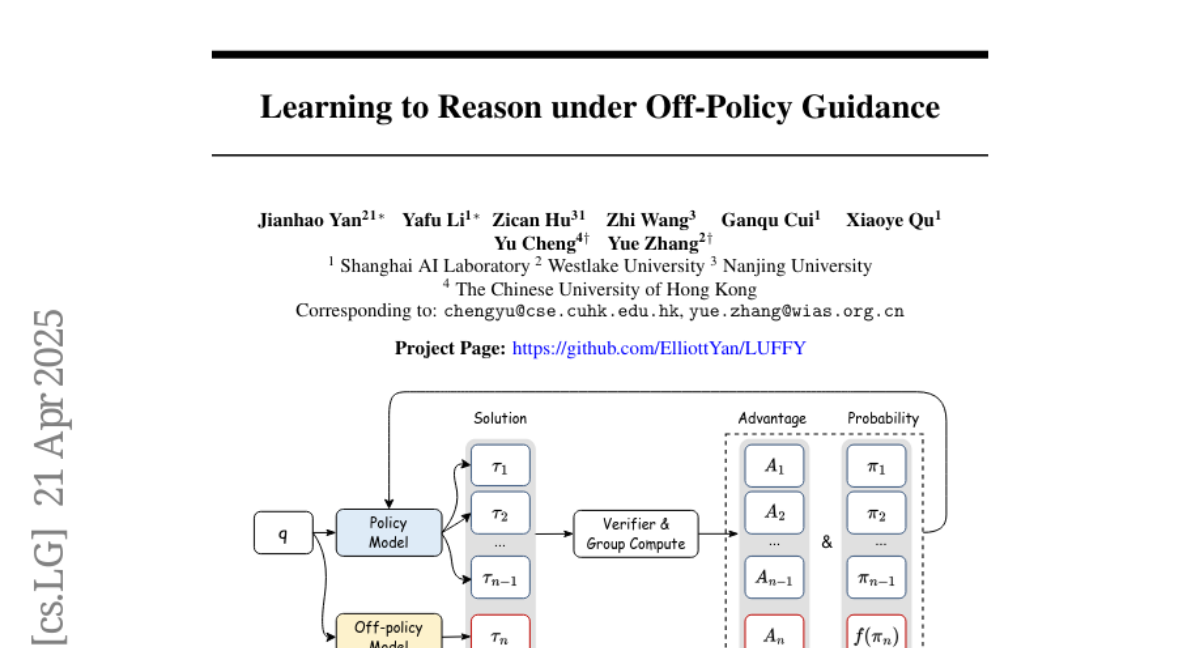
2. Eagle 2.5: Boosting Long-Context Post-Training for Frontier Vision-Language Models
🔑 Keywords: Vision-Language Models (VLMs), Long-Context Multimodal Learning, High-Resolution Image Understanding, Automatic Degrade Sampling, Eagle-Video-110K
💡 Category: Multi-Modal Learning
🌟 Research Objective:
– To develop Eagle 2.5, a family of frontier VLMs capable of addressing the challenges in long video comprehension and high-resolution image understanding.
🛠️ Research Methods:
– Introduced a training framework incorporating Automatic Degrade Sampling and Image Area Preservation to maintain contextual integrity and visual details, along with various efficiency optimizations for long-context data training.
💬 Research Conclusions:
– Eagle 2.5 exhibits significant improvements in long-context multimodal benchmarks, achieving similar performance to leading models such as GPT-4o and other large-scale open-source models.
👉 Paper link: https://huggingface.co/papers/2504.15271
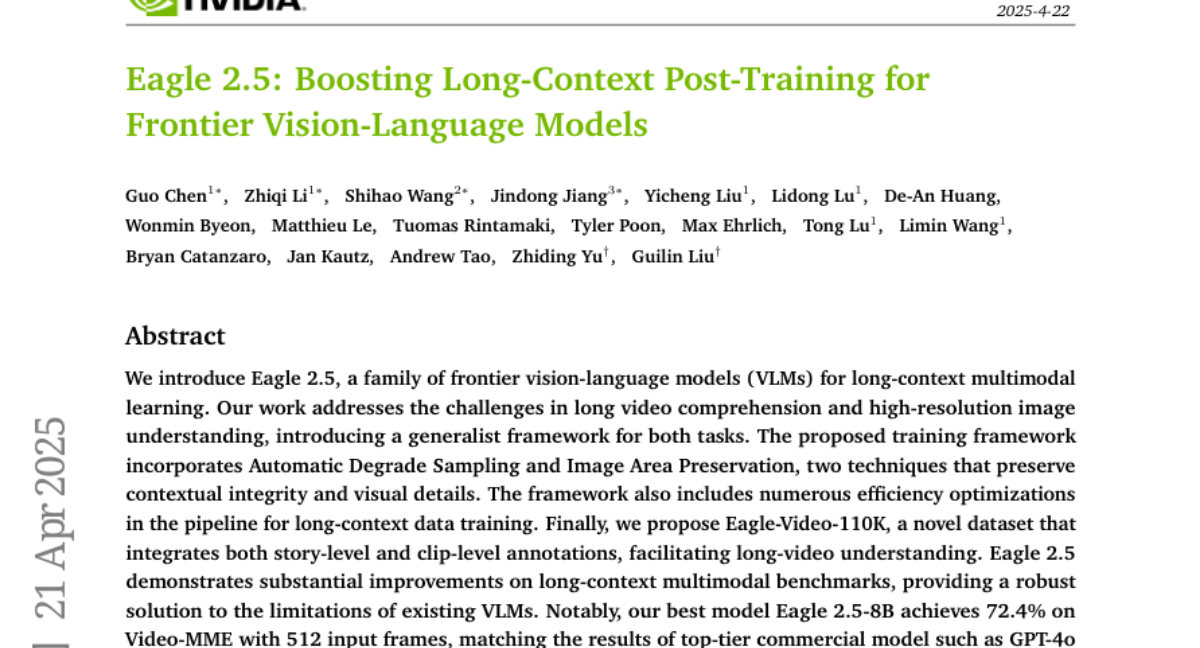
3. FlowReasoner: Reinforcing Query-Level Meta-Agents
🔑 Keywords: Meta-agent, Multi-agent systems, Reinforcement Learning, DeepSeek R1, Deliberative reasoning
💡 Category: AI Systems and Tools
🌟 Research Objective:
– The research aims to automate the design of query-level multi-agent systems, creating one system per user query through a meta-agent approach named FlowReasoner.
🛠️ Research Methods:
– The study employs DeepSeek R1 to instill basic reasoning abilities in FlowReasoner and further enhances it using reinforcement learning with external execution feedback. Additionally, a multi-purpose reward is designed to guide the training process focusing on performance, complexity, and efficiency.
💬 Research Conclusions:
– Experiments demonstrate FlowReasoner’s superiority over existing models, achieving a 10.52% higher accuracy than o1-mini across three engineering and competition code benchmarks. The code is available at the provided GitHub link.
👉 Paper link: https://huggingface.co/papers/2504.15257
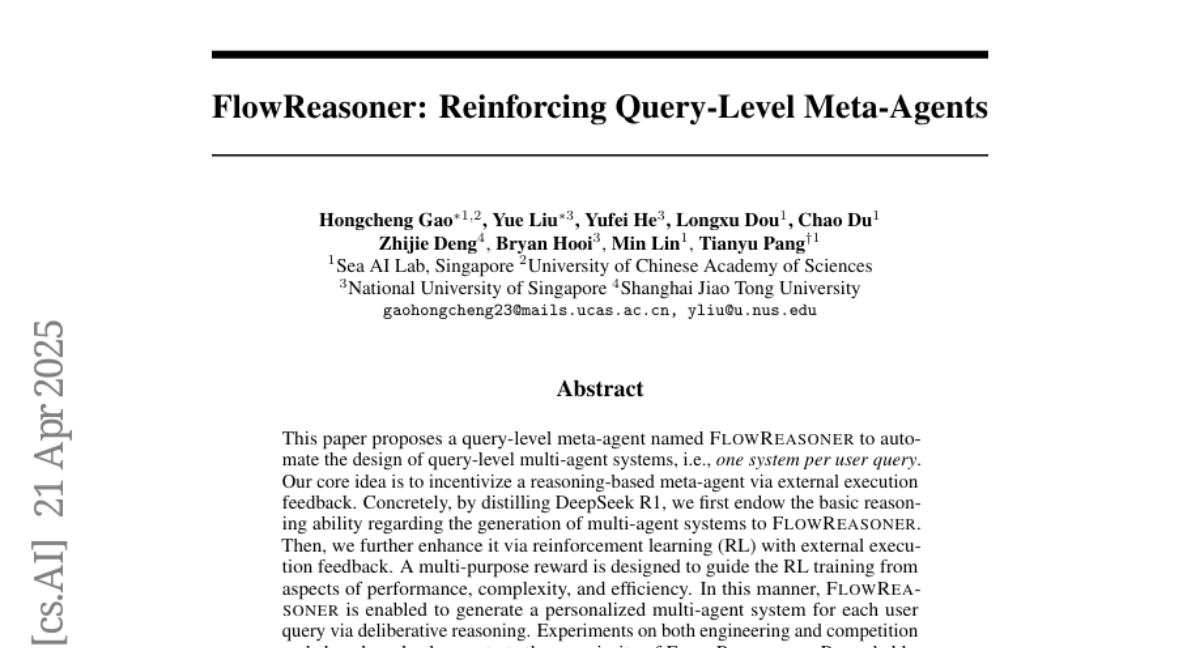
4. ToolRL: Reward is All Tool Learning Needs
🔑 Keywords: Large Language Models, Supervised Fine-Tuning, Reinforcement Learning, Reward Design, Group Relative Policy Optimization
💡 Category: Reinforcement Learning
🌟 Research Objective:
– To conduct a comprehensive study on reward design for tool use tasks within the reinforcement learning framework.
🛠️ Research Methods:
– Systematic exploration of various reward strategies with a focus on types, scales, granularity, and temporal dynamics.
– Implementation of a principled reward design in training LLMs using Group Relative Policy Optimization (GRPO).
💬 Research Conclusions:
– The proposed approach improves training stability and scalability, achieving a 17% performance increase over base models and a 15% improvement over SFT models.
– The study emphasizes the crucial role of detailed reward design in enhancing tool use capabilities and generalization of LLMs.
👉 Paper link: https://huggingface.co/papers/2504.13958
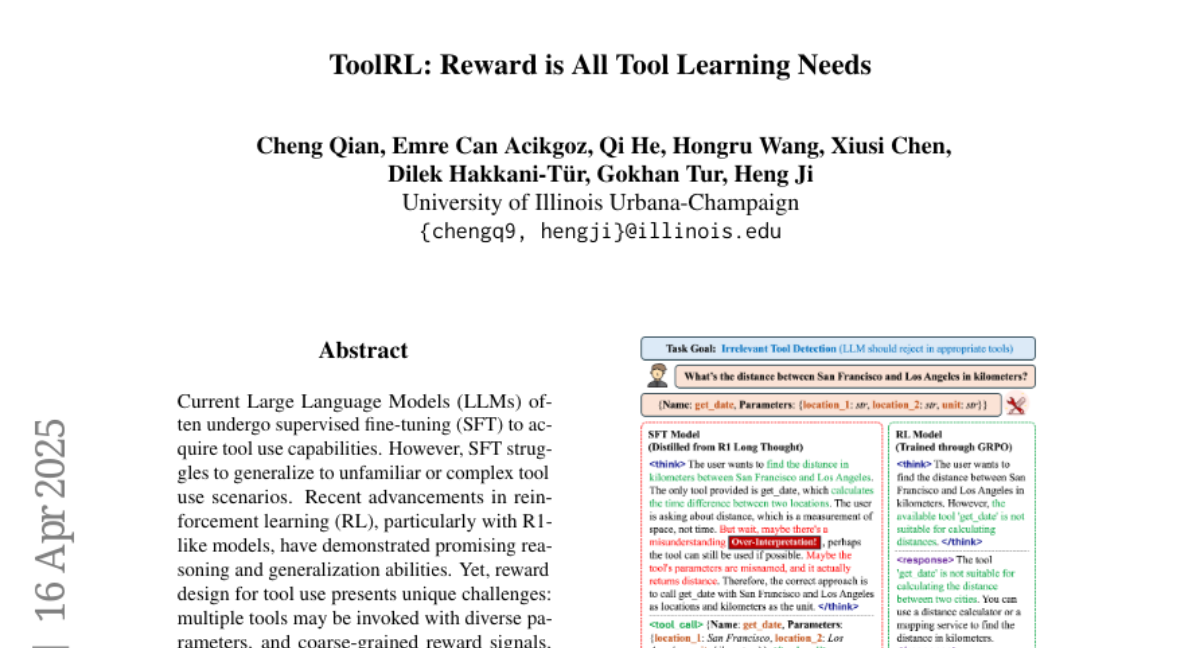
5. X-Teaming: Multi-Turn Jailbreaks and Defenses with Adaptive Multi-Agents
🔑 Keywords: Multi-turn interactions, Language models, X-Teaming, Attack scenarios, Safety alignment
💡 Category: Natural Language Processing
🌟 Research Objective:
– The paper aims to address safety risks in multi-turn interactions with language models by introducing a scalable framework called X-Teaming.
🛠️ Research Methods:
– X-Teaming employs collaborative agents for planning, attack optimization, and verification to achieve effective and diverse multi-turn jailbreak scenarios.
💬 Research Conclusions:
– X-Teaming demonstrates high success rates, achieving up to 98.1% across various models, and a 96.2% success rate against the Claude 3.7 Sonnet model. Additionally, the introduction of XGuard-Train provides a comprehensive dataset for enhancing multi-turn safety in LMs.
👉 Paper link: https://huggingface.co/papers/2504.13203
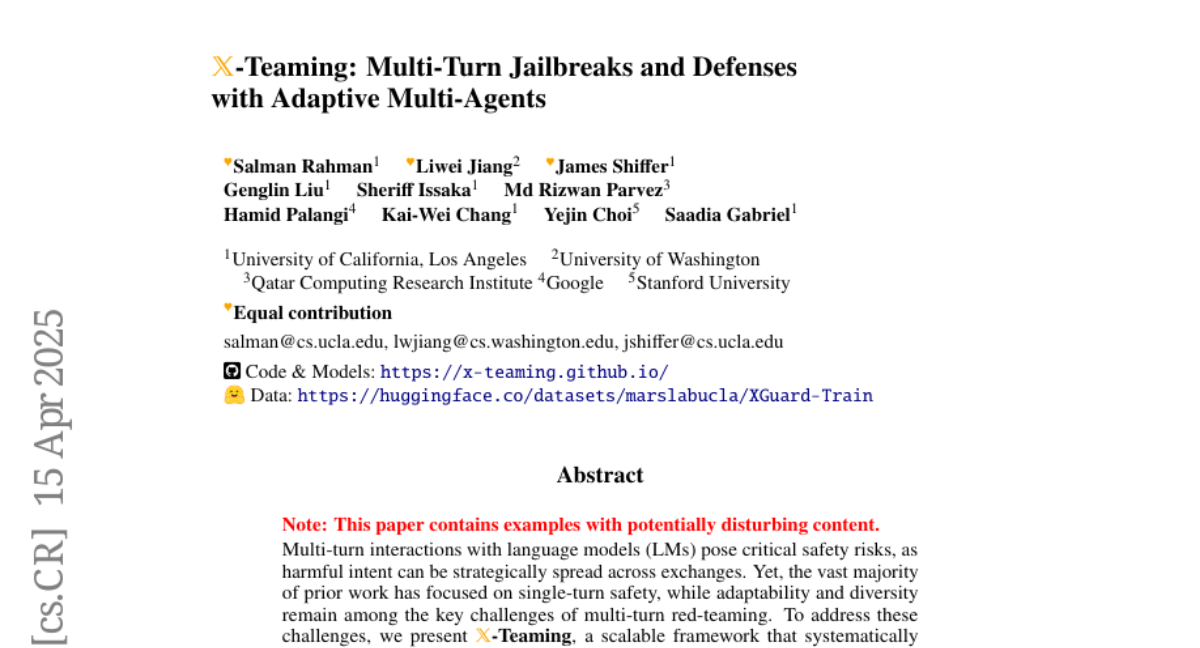
6. SphereDiff: Tuning-free Omnidirectional Panoramic Image and Video Generation via Spherical Latent Representation
🔑 Keywords: SphereDiff, 360-degree panoramic, Diffusion models, Spherical latent representation, Immersive AR/VR applications
💡 Category: Generative Models
🌟 Research Objective:
– To introduce a novel approach called SphereDiff for seamless generation of high-quality 360-degree panoramic images and videos using diffusion models.
🛠️ Research Methods:
– Defined a spherical latent representation to ensure uniform distribution, mitigating ERP distortions.
– Extended MultiDiffusion into spherical latent space and proposed a spherical latent sampling method.
– Introduced distortion-aware weighted averaging to enhance generation quality.
💬 Research Conclusions:
– SphereDiff outperforms existing methods in generating 360-degree panoramic content, maintaining high fidelity, and provides a robust solution for immersive AR/VR applications.
👉 Paper link: https://huggingface.co/papers/2504.14396
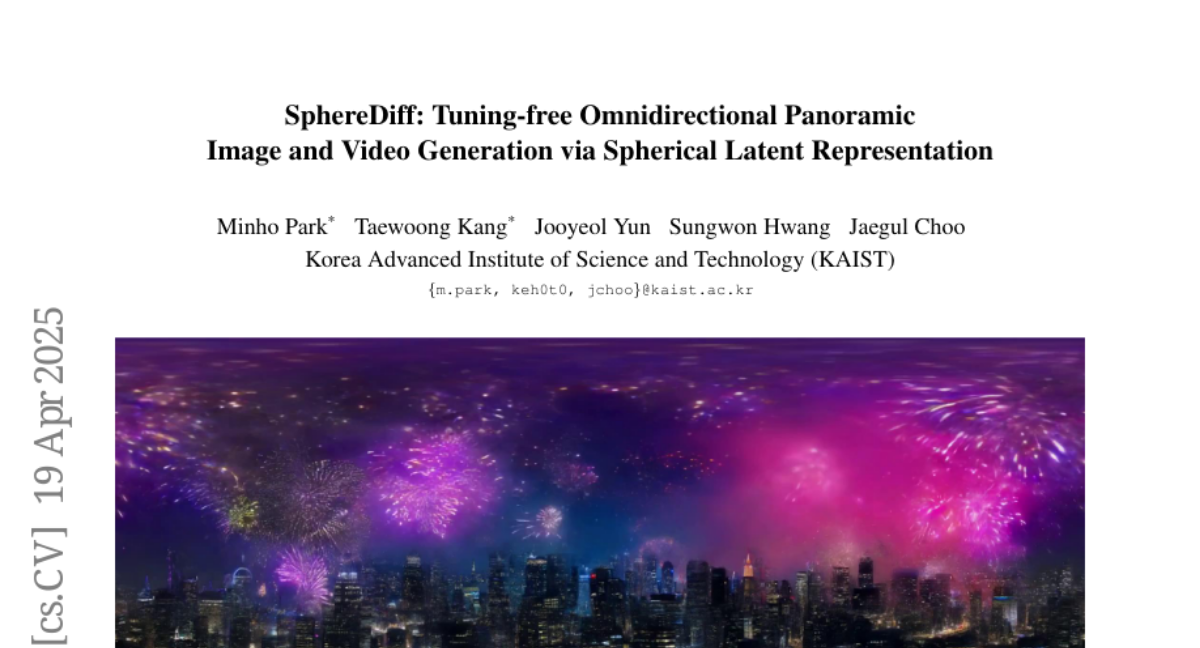
7. UFO2: The Desktop AgentOS
🔑 Keywords: CUAs, multimodal large language models, native APIs, task decomposition, OS integration
💡 Category: AI Systems and Tools
🌟 Research Objective:
– The study aims to enhance CUAs by improving desktop automation through deep OS integration and advanced multiagent architectures.
🛠️ Research Methods:
– Developed UFO2, which features a centralized HostAgent for task coordination and multiple AppAgents with native APIs, utilizing a hybrid control detection pipeline and speculative multi-action planning for efficiency.
💬 Research Conclusions:
– UFO2 demonstrates significant improvements in robustness and execution accuracy, offering a scalable path for reliable desktop automation through enhanced OS integration.
👉 Paper link: https://huggingface.co/papers/2504.14603
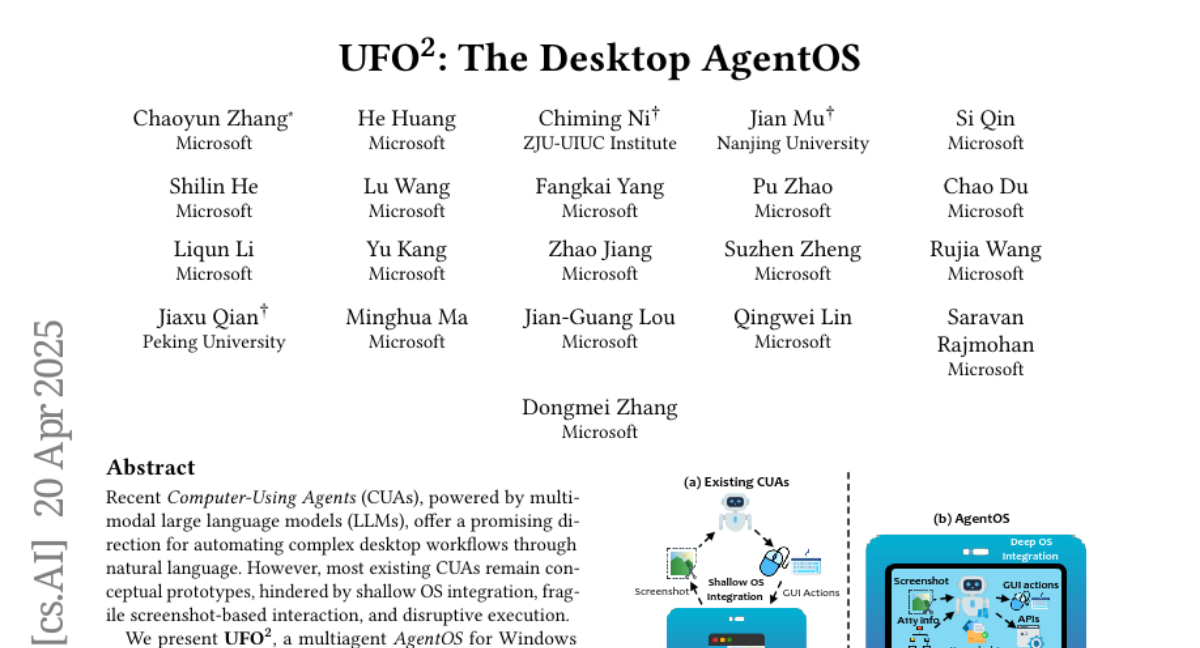
8. OTC: Optimal Tool Calls via Reinforcement Learning
🔑 Keywords: Tool-integrated reasoning, large language models, reinforcement learning, efficiency, tool calls
💡 Category: Reinforcement Learning
🌟 Research Objective:
– To develop a framework, OTC-PO, that enhances the accuracy and efficiency of Tool-integrated reasoning in large language models by minimizing unnecessary tool calls.
🛠️ Research Methods:
– Introduction of an RL-based framework, Optimized Tool Call-controlled Policy Optimization (OTC-PO), incorporating Proximal Policy Optimization (PPO) and Group Relative Preference Optimization (GRPO).
– Utilization of a tool-integrated reward system that balances correctness and tool efficiency.
💬 Research Conclusions:
– The proposed framework OTC-PPO and OTC-GRPO significantly reduce tool calls by up to 73.1% while enhancing tool productivity by up to 229.4%, without sacrificing accuracy.
– Marks the first RL-based approach focusing on optimizing tool-use efficiency in tool-integrated reasoning.
👉 Paper link: https://huggingface.co/papers/2504.14870
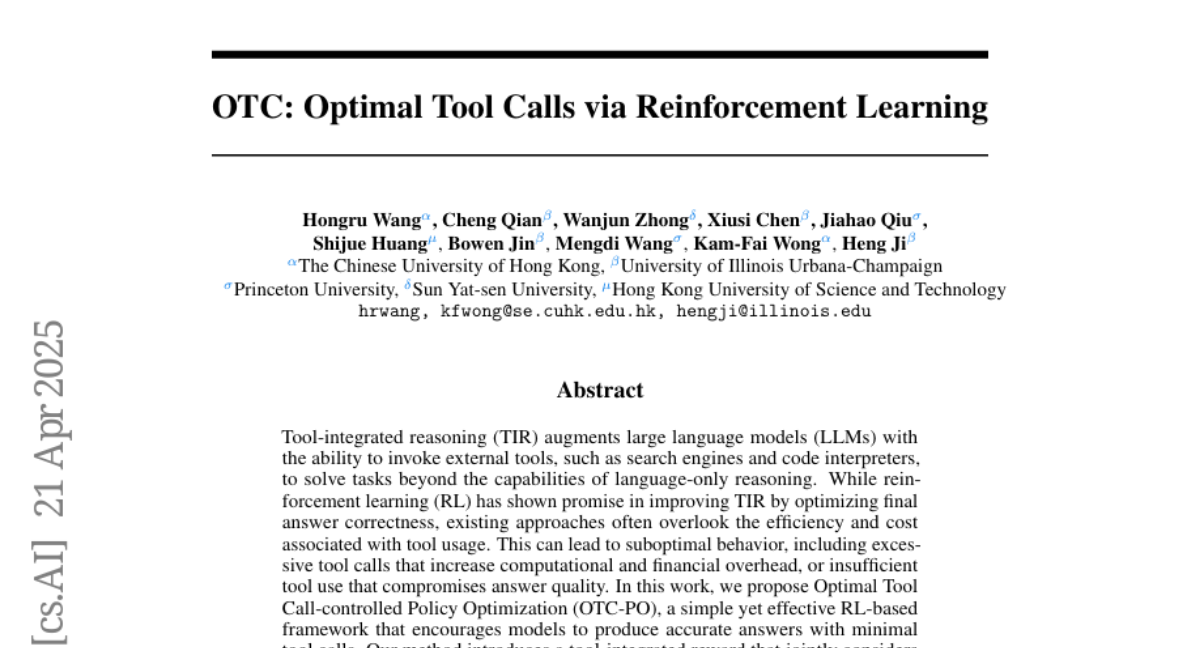
9. StyleMe3D: Stylization with Disentangled Priors by Multiple Encoders on 3D Gaussians
🔑 Keywords: 3D Gaussian Splatting, StyleMe3D, multi-level semantic alignment, perceptual quality enhancement, Dynamic Style Score Distillation
💡 Category: Generative Models
🌟 Research Objective:
– The paper aims to address challenges in stylized 3D scene reconstruction by proposing a framework, StyleMe3D, for effective 3D GS style transfer.
🛠️ Research Methods:
– The proposed method includes multi-modal style conditioning, multi-level semantic alignment, and specific innovations such as Dynamic Style Score Distillation, Contrastive Style Descriptor, Simultaneously Optimized Scale, and 3D Gaussian Quality Assessment to enhance stylistic and perceptual quality.
💬 Research Conclusions:
– The framework significantly improves upon existing methods by preserving geometric details and achieving stylistic consistency in both isolated objects and complex scenes, facilitating real-time rendering applications in areas like gaming and digital art.
👉 Paper link: https://huggingface.co/papers/2504.15281
10. THOUGHTTERMINATOR: Benchmarking, Calibrating, and Mitigating Overthinking in Reasoning Models
🔑 Keywords: Reasoning models, Overthinking, Problem-level difficulty, DUMB500, THOUGHTTERMINATOR
💡 Category: Knowledge Representation and Reasoning
🌟 Research Objective:
– The study aims to address the issue of overthinking in reasoning models by examining the relationship between problem difficulty and token spending.
🛠️ Research Methods:
– The authors introduce approximate measures of problem-level difficulty and evaluate reasoning models on their efficiency in token allocation. They use the DUMB500 dataset to test model calibration on easy problems and employ THOUGHTTERMINATOR, a training-free black box decoding technique, to improve calibration.
💬 Research Conclusions:
– It was found that reasoning models are often poorly calibrated, especially on easier problems. The introduction of THOUGHTTERMINATOR significantly enhances the calibration of reasoning models.
👉 Paper link: https://huggingface.co/papers/2504.13367
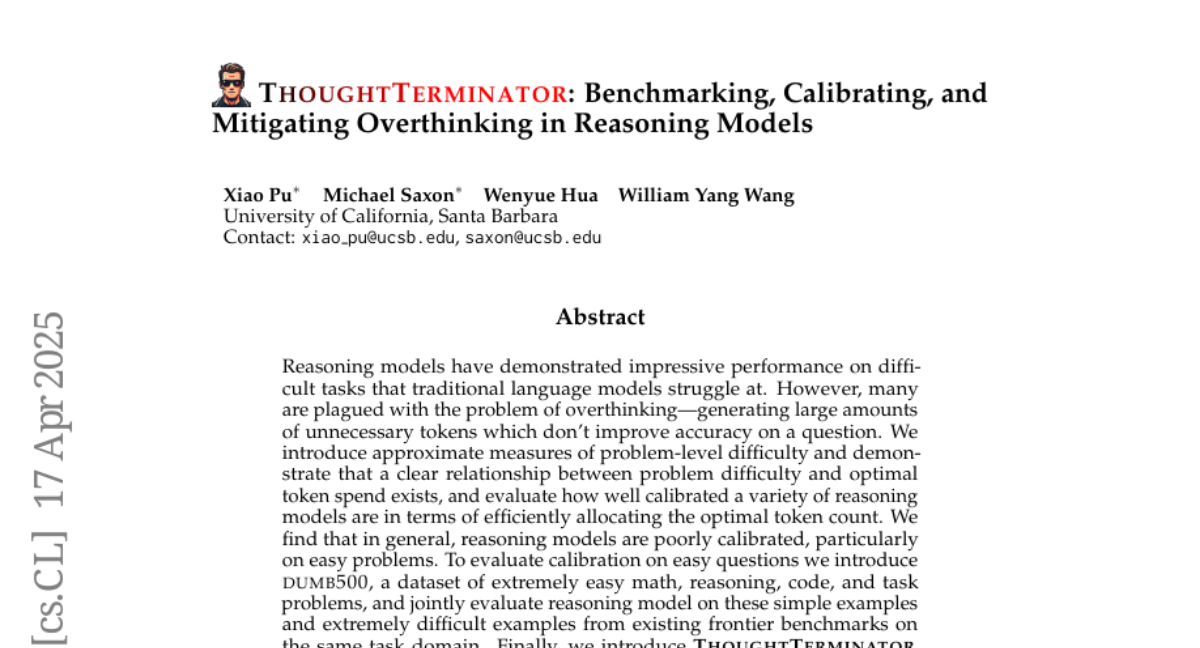
11. EasyEdit2: An Easy-to-use Steering Framework for Editing Large Language Models
🔑 Keywords: EasyEdit2, Large Language Model, test-time interventions, seamless model steering
💡 Category: Natural Language Processing
🌟 Research Objective:
– The objective is to introduce EasyEdit2, a framework designed for plug-and-play adjustability to control Large Language Model behaviors without modifying its parameters.
🛠️ Research Methods:
– EasyEdit2 employs modules like the steering vector generator and the steering vector applier to automatically generate and apply steering vectors for model behavior adjustment.
💬 Research Conclusions:
– EasyEdit2 provides a user-friendly approach for precise control of model responses, demonstrating effective model steering performance across different LLMs; source code and demonstration available on GitHub.
👉 Paper link: https://huggingface.co/papers/2504.15133
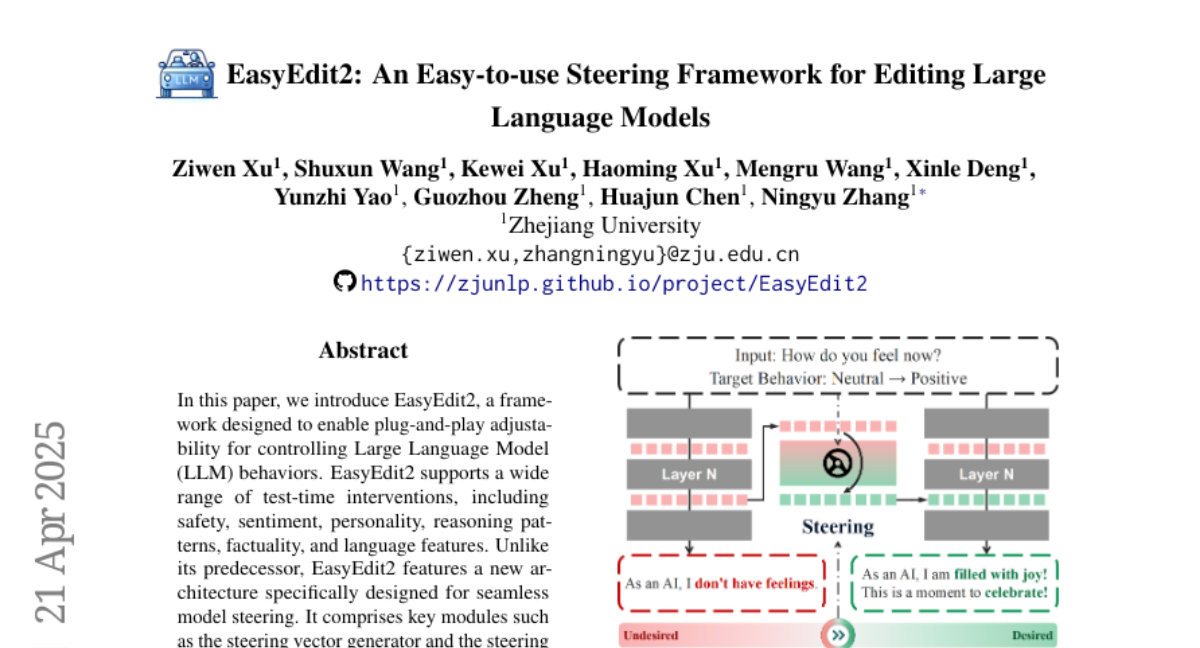
12. LeetCodeDataset: A Temporal Dataset for Robust Evaluation and Efficient Training of Code LLMs
🔑 Keywords: LeetCodeDataset, code-generation models, LLM research, evaluation, supervised fine-tuning
💡 Category: Natural Language Processing
🌟 Research Objective:
– Introduce LeetCodeDataset as a benchmark for evaluating and training code-generation models to enhance reasoning-focused coding benchmarks and self-contained training testbeds.
🛠️ Research Methods:
– Curated LeetCode Python problems with rich metadata, broad coverage, 100+ test cases per problem, and temporal splits for contamination-free evaluation and efficient supervised fine-tuning.
💬 Research Conclusions:
– Reasoning models significantly outperform non-reasoning counterparts, and supervised fine-tuning with 2.6K model-generated solutions achieves comparable performance to 110K-sample counterparts.
👉 Paper link: https://huggingface.co/papers/2504.14655
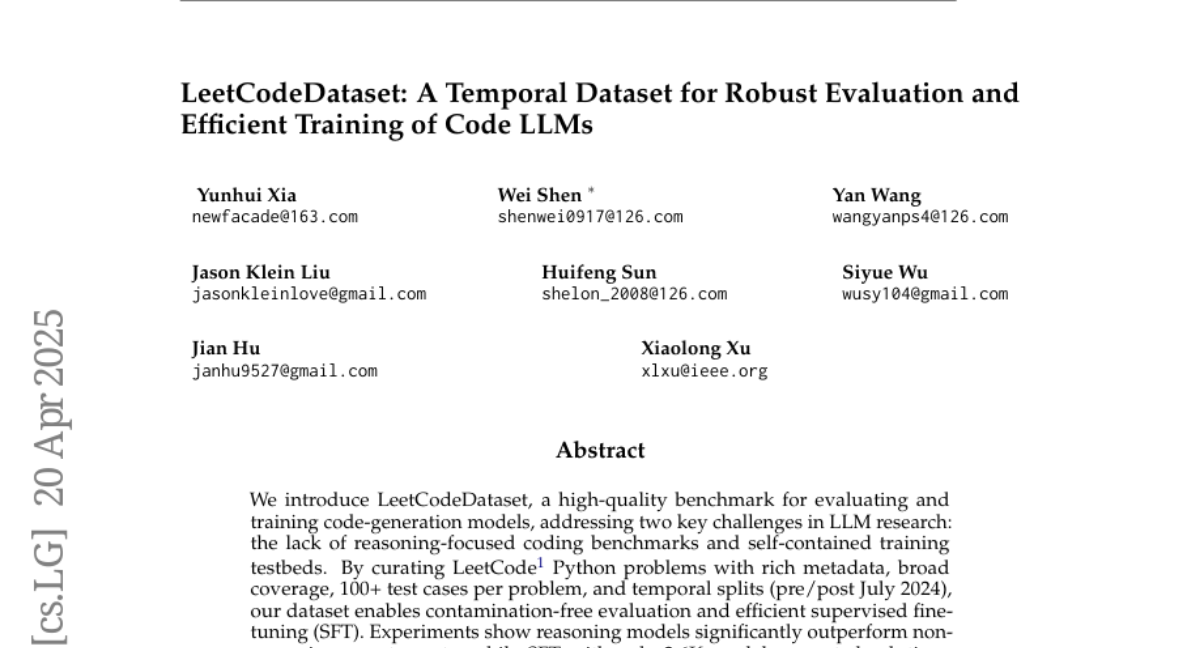
13. Seeing from Another Perspective: Evaluating Multi-View Understanding in MLLMs
🔑 Keywords: Multi-view Understanding, Multi-Modal Large Language Models, All-Angles Bench, Geometric Consistency, Cross-view Correspondence
💡 Category: Multi-Modal Learning
🌟 Research Objective:
– To evaluate the challenges faced by Multi-Modal Large Language Models (MLLMs) in multi-view scene reasoning and enhance their performance as embodied agents.
🛠️ Research Methods:
– Developed the All-Angles Bench, a benchmark comprising over 2,100 human-annotated multi-view question-answer pairs across 90 diverse real-world scenes, designed to specifically test models on six tasks related to geometric correspondence and multi-view alignment.
💬 Research Conclusions:
– Current MLLMs demonstrate a substantial performance gap compared to human evaluators, particularly in cross-view correspondence and establishing coarse camera poses, indicating the need for domain-specific refinements to improve multi-view awareness.
👉 Paper link: https://huggingface.co/papers/2504.15280
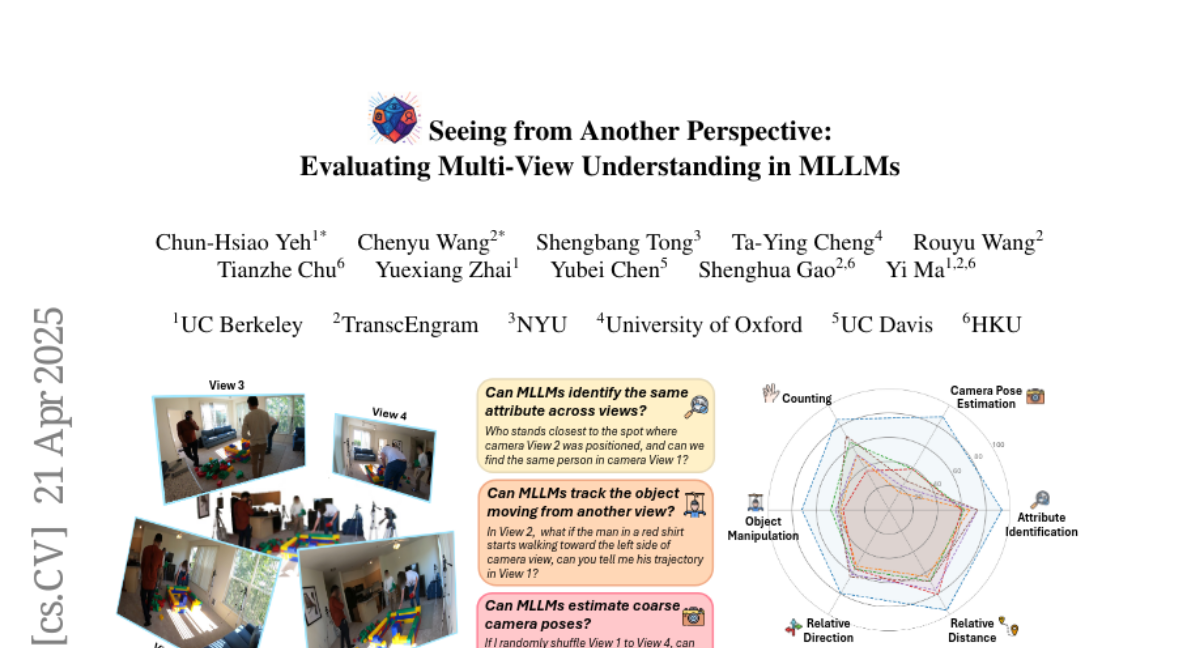
14. InfiGUI-R1: Advancing Multimodal GUI Agents from Reactive Actors to Deliberative Reasoners
🔑 Keywords: Multimodal Large Language Models, GUI Agents, Actor2Reasoner framework, Reinforcement Learning
💡 Category: Multi-Modal Learning
🌟 Research Objective:
– The main aim is to advance GUI Agents from Reactive Actors to Deliberative Reasoners using the Actor2Reasoner framework.
🛠️ Research Methods:
– The methodology includes a two-stage training approach with Reasoning Injection to establish basic reasoning and Deliberation Enhancement to refine reasoning skills using Spatial Reasoning Distillation and Reinforcement Learning.
💬 Research Conclusions:
– The introduction of InfiGUI-R1 shows strong performance in GUI grounding and trajectory tasks, demonstrating the feasibility of progressing agents toward deliberate reasoning.
👉 Paper link: https://huggingface.co/papers/2504.14239
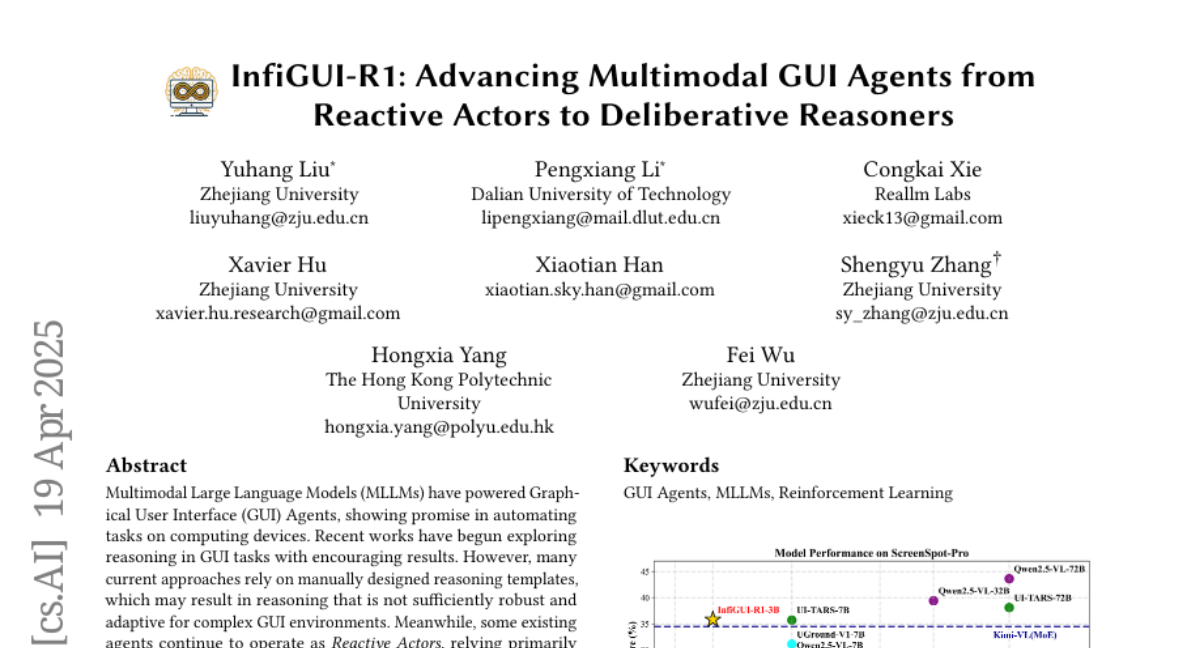
15. Uni3C: Unifying Precisely 3D-Enhanced Camera and Human Motion Controls for Video Generation
🔑 Keywords: Uni3C, plug-and-play control module, PCDController, 3D priors, camera controllability
💡 Category: Computer Vision
🌟 Research Objective:
– The research introduces Uni3C, a unified 3D-enhanced framework for precise control of both camera and human motion in video generation.
🛠️ Research Methods:
– A plug-and-play control module, PCDController, utilizing unprojected point clouds from monocular depth is proposed to achieve accurate camera control.
💬 Research Conclusions:
– Uni3C offers superior robustness and performance in camera controllability and human motion quality, outperforming competitors and validated with tailored challenging tests.
👉 Paper link: https://huggingface.co/papers/2504.14899
16. LearnAct: Few-Shot Mobile GUI Agent with a Unified Demonstration Benchmark
🔑 Keywords: Mobile GUI agents, human demonstrations, LearnGUI, LearnAct, demonstration-based learning
💡 Category: AI Systems and Tools
🌟 Research Objective:
– To enhance mobile GUI agent capabilities through human demonstrations, prioritizing performance in unseen scenarios over universal generalization.
🛠️ Research Methods:
– Introduced LearnGUI, the first comprehensive dataset for demonstration-based learning in mobile GUI agents.
– Developed LearnAct, a multi-agent framework that uses specific agents for knowledge extraction, retrieval, and task execution.
💬 Research Conclusions:
– Demonstration-based learning significantly improves task performance of mobile GUI agents, with substantial accuracy increases in both offline and online evaluations.
👉 Paper link: https://huggingface.co/papers/2504.13805
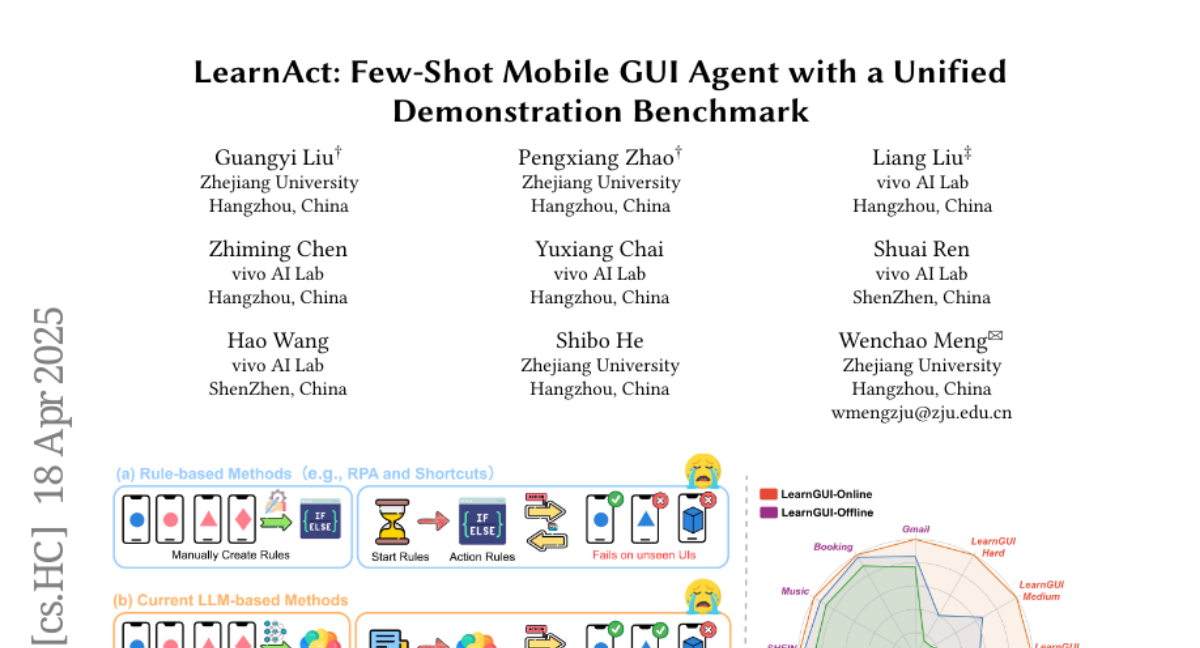
17. LookingGlass: Generative Anamorphoses via Laplacian Pyramid Warping
🔑 Keywords: Anamorphosis, Generative perceptual illusions, Latent rectified flow models, Laplacian Pyramid Warping
💡 Category: Generative Models
🌟 Research Objective:
– The study aims to revisit anamorphic images with a generative twist, making them interpretable both directly and from specific viewpoints.
🛠️ Research Methods:
– The researchers utilized latent rectified flow models and introduced a frequency-aware technique called Laplacian Pyramid Warping to generate high-quality anamorphic images.
💬 Research Conclusions:
– The work extends Visual Anagrams to latent space models, enabling the creation of novel generative perceptual illusions through diverse spatial transforms.
👉 Paper link: https://huggingface.co/papers/2504.08902
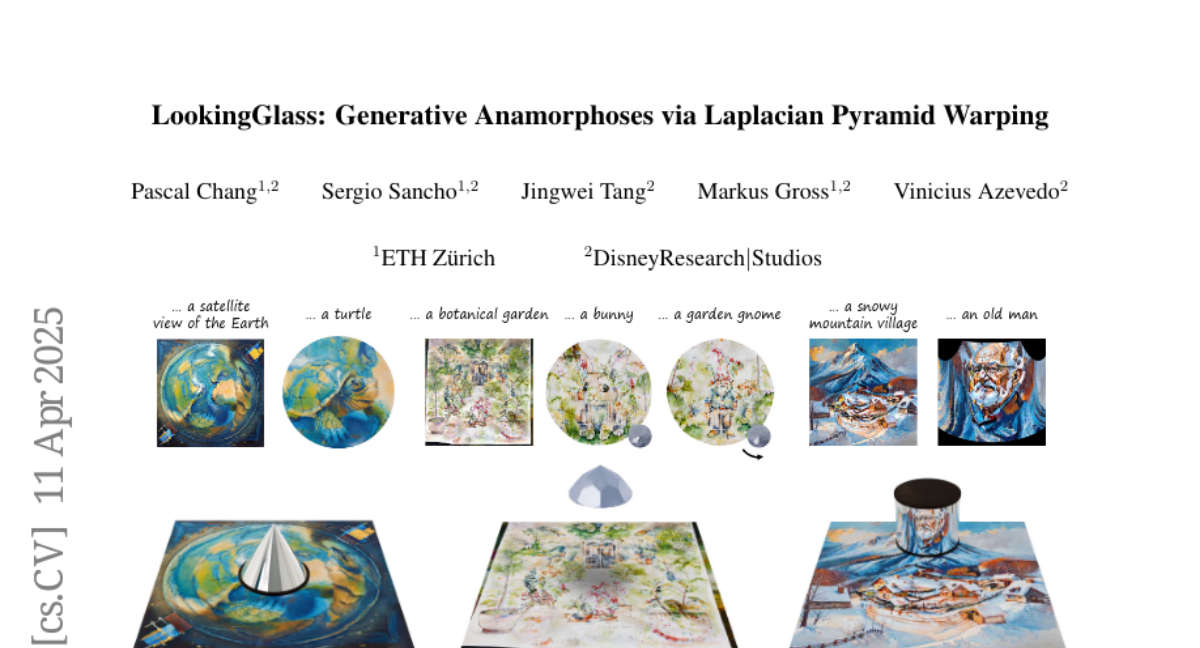
18. An LMM for Efficient Video Understanding via Reinforced Compression of Video Cubes
🔑 Keywords: Large Multimodal Models, Gumbel Softmax, Spatiotemporal Redundancy, Video-MME, Cubing Network
💡 Category: Multi-Modal Learning
🌟 Research Objective:
– Introduce Quicksviewer, a new paradigm for efficient video understanding by partitioning videos with varying temporal density.
🛠️ Research Methods:
– Utilizes a Gumbel Softmax approach to dynamically compress video data, followed by unified resampling, leveraging a language backbone through progressive training stages.
💬 Research Conclusions:
– Achieves 45x compression rate in video spatiotemporal data, outperforms baselines by up to 8.72 accuracy, and demonstrates SOTA performance in Video-MME with minimal resource usage.
👉 Paper link: https://huggingface.co/papers/2504.15270
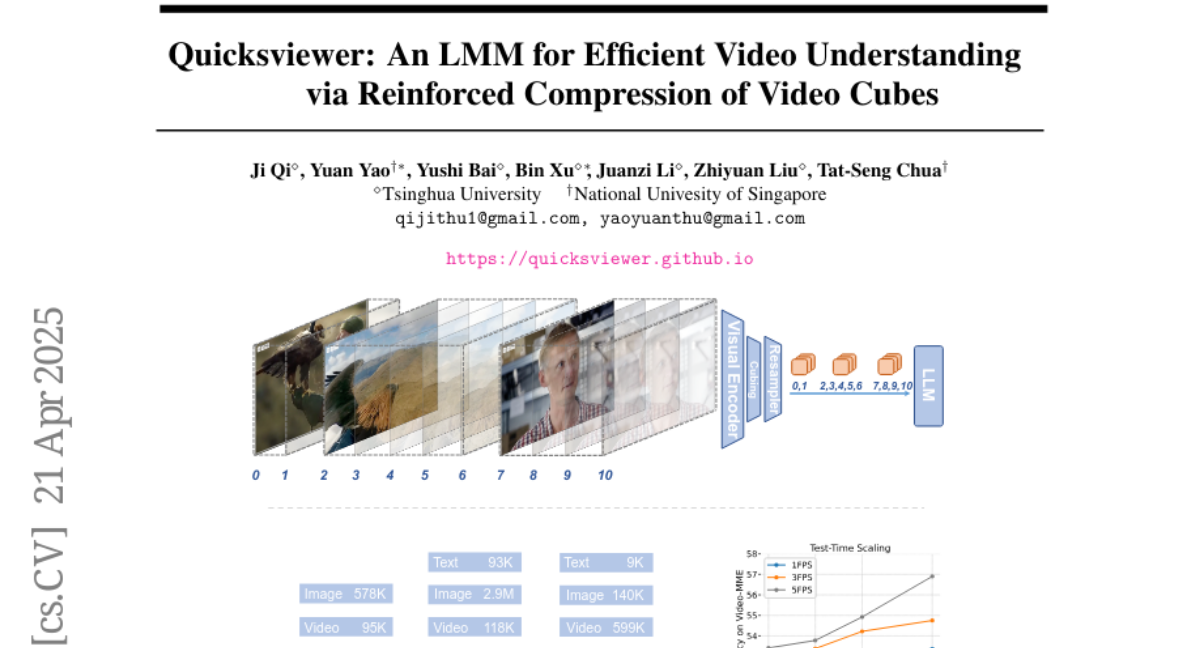
19. NEMOTRON-CROSSTHINK: Scaling Self-Learning beyond Math Reasoning
🔑 Keywords: Large Language Models, Reinforcement Learning, Generalization, NEMOTRON-CROSSTHINK, Verifiable Reward Modeling
💡 Category: Reinforcement Learning
🌟 Research Objective:
– To enhance the generalization capabilities of Large Language Models (LLMs) for diverse reasoning tasks beyond mathematical reasoning, using a new framework called NEMOTRON-CROSSTHINK.
🛠️ Research Methods:
– Incorporation of multi-domain corpora, application of structured templates, filtering for verifiable answers, and optimization of data blending strategies in Reinforcement Learning training.
💬 Research Conclusions:
– The NEMOTRON-CROSSTHINK framework enables scalable and verifiable reward modeling, leading to significant improvements in accuracy and response efficiency across both mathematical and non-mathematical reasoning tasks.
👉 Paper link: https://huggingface.co/papers/2504.13941
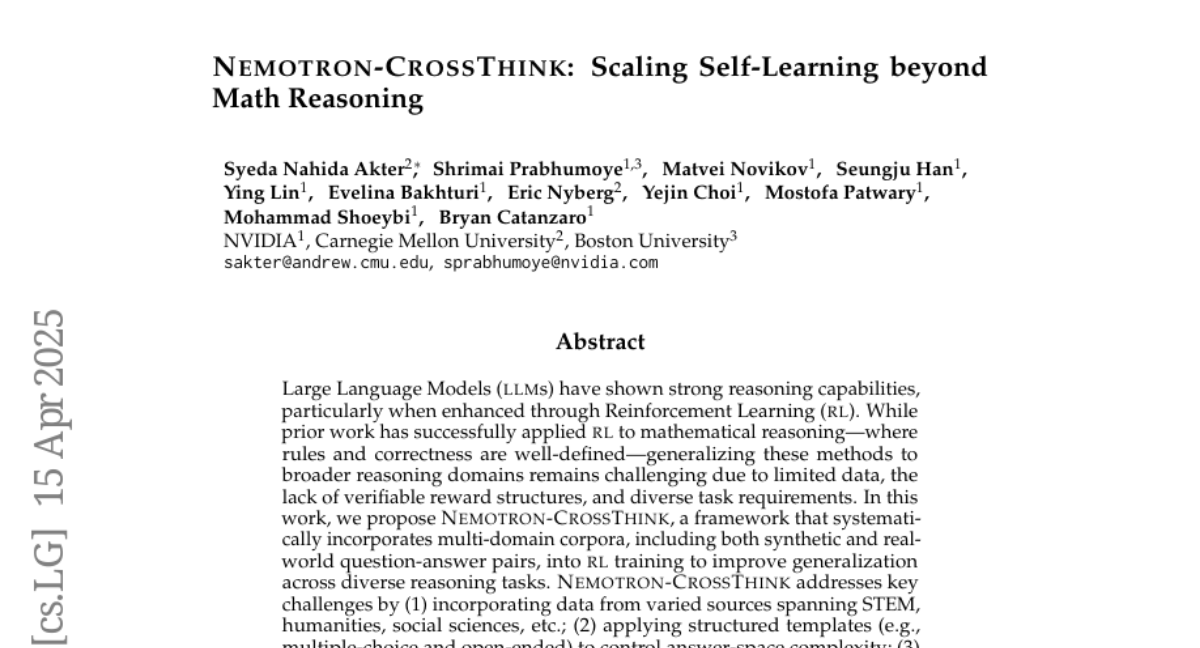
20. DRAGON: Distributional Rewards Optimize Diffusion Generative Models
🔑 Keywords: Generative Optimization, Fine-Tuning, Media Generation Models, Reward Functions
💡 Category: Generative Models
🌟 Research Objective:
– The aim is to present a new framework, DRAGON, for optimizing media generation models towards desired outcomes using versatile reward functions.
🛠️ Research Methods:
– Utilizes a flexible framework that evaluates reward functions on individual examples or their distributions and applies various cross-modality encoders.
– Conducts experiments with an audio-domain text-to-music diffusion model using 20 different reward functions to assess performance.
💬 Research Conclusions:
– DRAGON demonstrates high performance with an 81.45% average win rate across rewards and enhances music generation quality without human preference annotations.
– Exemplar-based reward functions are effective and comparable to model-based approaches in improving human-perceived quality.
👉 Paper link: https://huggingface.co/papers/2504.15217
21. TAPIP3D: Tracking Any Point in Persistent 3D Geometry
🔑 Keywords: TAPIP3D, 3D point tracking, 3D trajectory estimation, camera-stabilized, Local Pair Attention mechanism
💡 Category: Computer Vision
🌟 Research Objective:
– Introduce TAPIP3D, a novel method for robust long-term 3D point tracking in monocular RGB and RGB-D videos.
🛠️ Research Methods:
– Represent videos as camera-stabilized spatio-temporal feature clouds, leveraging depth and camera motion.
– Propose a Local Pair Attention mechanism to handle 3D point distribution irregularities and estimate precise 3D trajectories.
💬 Research Conclusions:
– TAPIP3D outperforms existing 3D and 2D tracking methods by stabilizing camera motion and forming better feature neighborhoods.
– Enhanced tracking accuracy in both 3D and 2D, supporting inference in both camera and world coordinates.
👉 Paper link: https://huggingface.co/papers/2504.14717
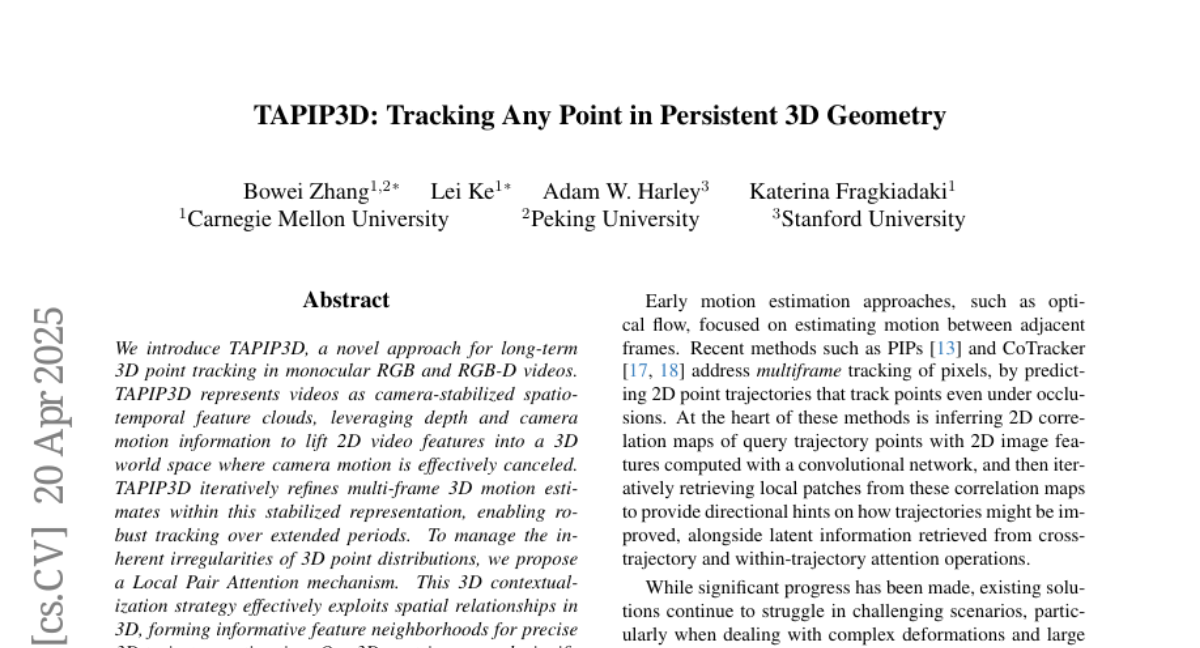
22. RainbowPlus: Enhancing Adversarial Prompt Generation via Evolutionary Quality-Diversity Search
🔑 Keywords: Large Language Models, Adversarial Prompts, Evolutionary Computation, Red-Teaming, Vulnerability Assessment
💡 Category: Natural Language Processing
🌟 Research Objective:
– Introduce RainbowPlus, a novel red-teaming framework, to enhance the generation of adversarial prompts through adaptive quality-diversity search and evolutionary computation.
🛠️ Research Methods:
– Utilized evolutionary algorithms like MAP-Elites, employing a multi-element archive and a comprehensive fitness function to store and evaluate diverse high-quality prompts.
💬 Research Conclusions:
– RainbowPlus demonstrated superior attack success rates and prompt diversity compared to existing QD methods across multiple datasets and LLMs, achieving faster performance and generating significantly more unique prompts.
👉 Paper link: https://huggingface.co/papers/2504.15047
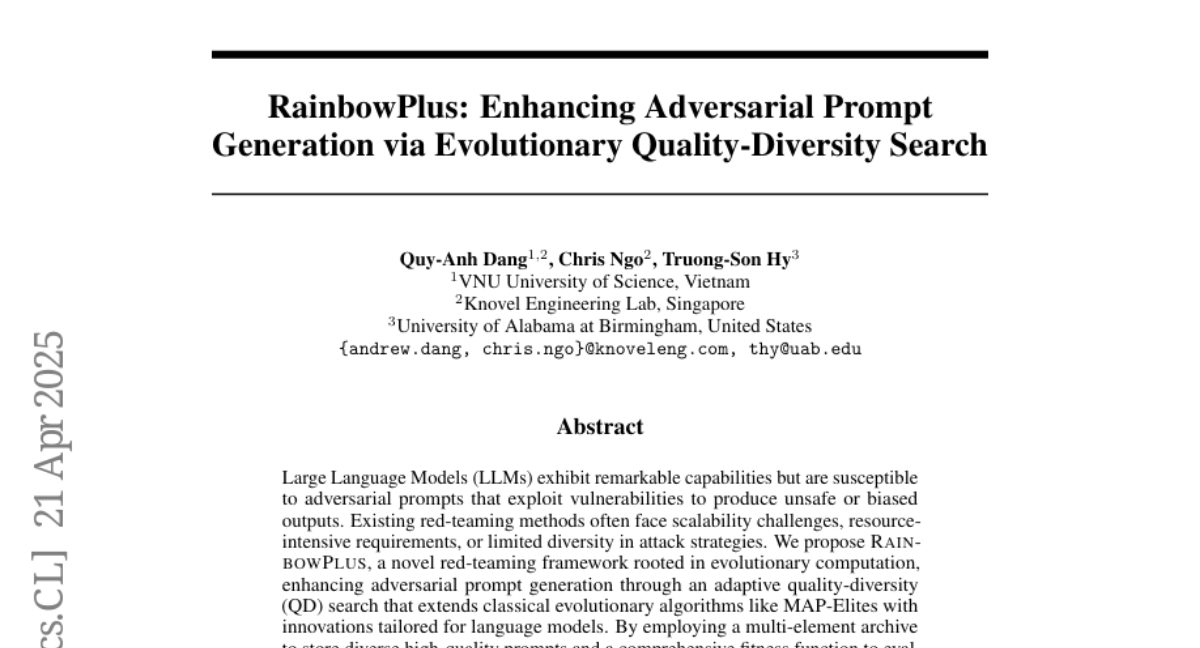
23. RF-DETR Object Detection vs YOLOv12 : A Study of Transformer-based and CNN-based Architectures for Single-Class and Multi-Class Greenfruit Detection in Complex
Orchard Environments Under Label Ambiguity
🔑 Keywords: RF-DETR, YOLOv12, Object Detection, Precision Agriculture, Transformer-based Architectures
💡 Category: Computer Vision
🌟 Research Objective:
– To compare RF-DETR and YOLOv12 object detection models for detecting greenfruits in complex orchard environments.
🛠️ Research Methods:
– Developed a custom dataset with single-class and multi-class annotations.
– Analyzed model performance under real-world conditions marked by label ambiguity and occlusion using metrics such as mean Average Precision.
💬 Research Conclusions:
– RF-DETR excels in global context modeling, effectively identifying partially occluded or ambiguous greenfruits, achieving a high mAP50 of 0.9464 in single-class detection.
– YOLOv12 optimizes for computational efficiency, excelling in edge deployment scenarios, with high mAP@50:95 scores indicating better classification in detailed contexts.
– RF-DETR’s swift convergence in training demonstrates the efficiency of transformer-based architectures for precision agricultural applications.
👉 Paper link: https://huggingface.co/papers/2504.13099
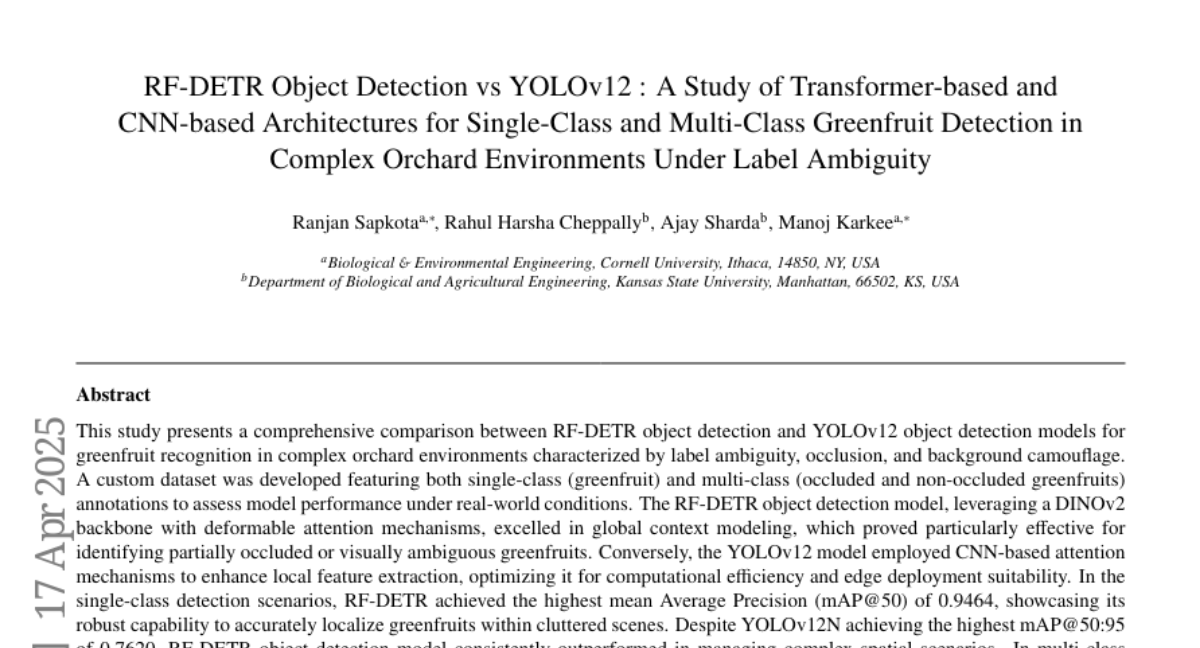
24. CoMotion: Concurrent Multi-person 3D Motion
🔑 Keywords: 3D poses, monocular camera, temporally coherent predictions, online tracking, pseudo-labeled annotations
💡 Category: Computer Vision
🌟 Research Objective:
– Introduce a method for detecting and tracking detailed 3D poses of multiple people using a single monocular camera.
🛠️ Research Methods:
– Utilize temporally coherent predictions and direct pose updates from new input images to enhance tracking in crowded scenes with occlusions.
– Leverage pseudo-labeled annotations from numerous datasets to train the model.
💬 Research Conclusions:
– Developed a model that matches state-of-the-art 3D pose estimation accuracy but offers improved speed and accuracy in tracking multiple people over time.
👉 Paper link: https://huggingface.co/papers/2504.12186
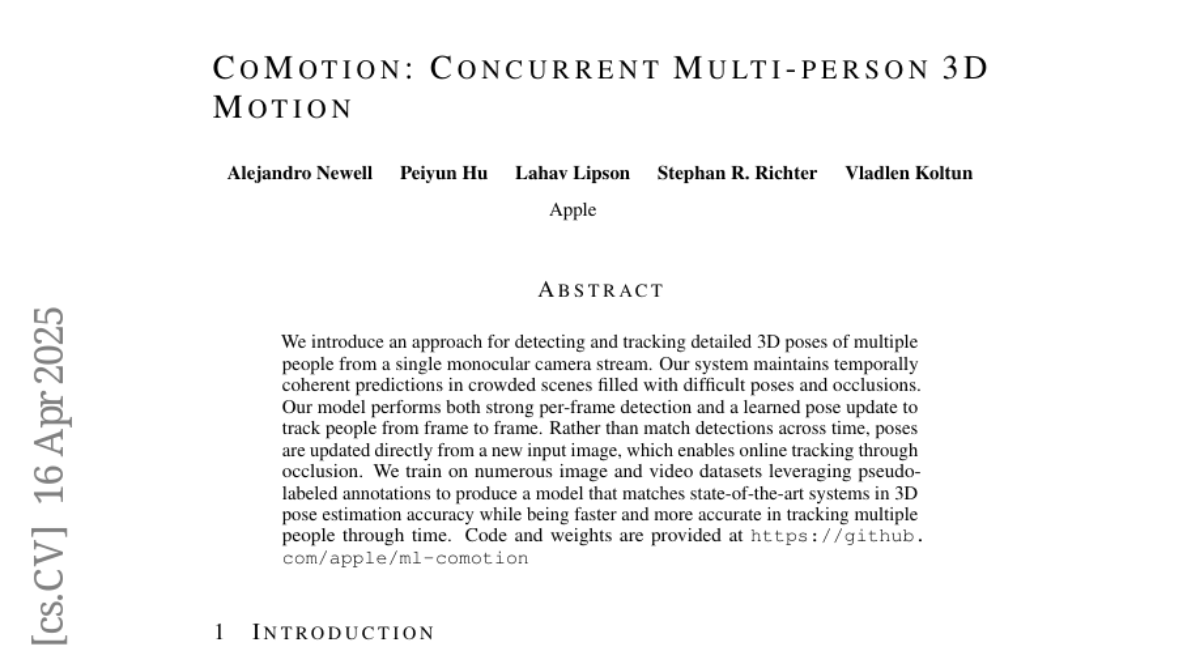
25. SilVar-Med: A Speech-Driven Visual Language Model for Explainable Abnormality Detection in Medical Imaging
🔑 Keywords: Medical Visual Language Models, Speech-driven, Multimodal, Medical image analysis, Voice-based communication
💡 Category: AI in Healthcare
🌟 Research Objective:
– To address the limitations of text-based interactions in medical Visual Language Models (VLM) and to introduce an end-to-end speech-driven medical VLM called SilVar-Med for improved usability in clinical environments.
🛠️ Research Methods:
– Developed a multimodal medical image assistant integrating speech interaction with Visual Language Models, and introduced a reasoning dataset for interpreting medical image predictions.
💬 Research Conclusions:
– Demonstrated the potential for more transparent, interactive, and clinically viable diagnostic support systems, offering proof-of-concept for reasoning-driven medical image interpretation using end-to-end speech interaction.
👉 Paper link: https://huggingface.co/papers/2504.10642
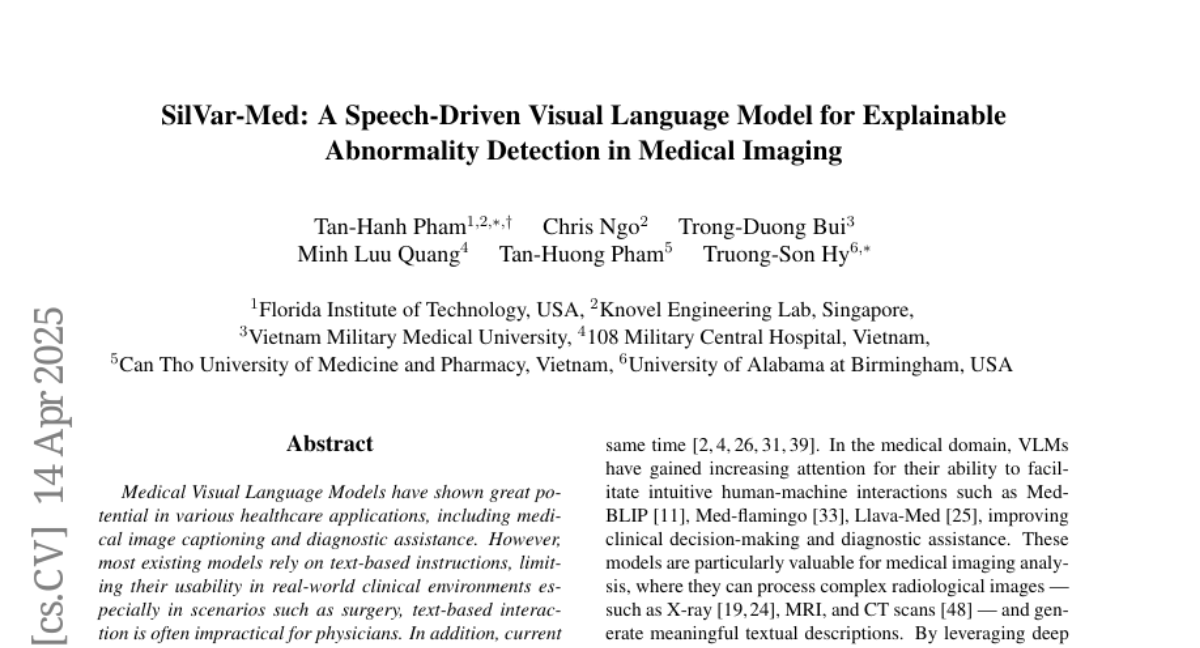
26. LoftUp: Learning a Coordinate-Based Feature Upsampler for Vision Foundation Models
🔑 Keywords: Vision Foundation Models, Feature Upsampling, Cross-Attention Transformer, High-Resolution Images, Self-Distillation
💡 Category: Computer Vision
🌟 Research Objective:
– To enhance feature upsampling in Vision Foundation Models for improved pixel-level understanding by investigating upsampler architecture and training objectives.
🛠️ Research Methods:
– Introduced a coordinate-based cross-attention transformer integrating high-resolution images with coordinates and low-resolution features.
– Proposed using high-resolution pseudo-groundtruth features through class-agnostic masks and self-distillation.
💬 Research Conclusions:
– The proposed approach captures fine-grained details effectively and outperforms existing feature upsampling techniques across various downstream tasks.
👉 Paper link: https://huggingface.co/papers/2504.14032
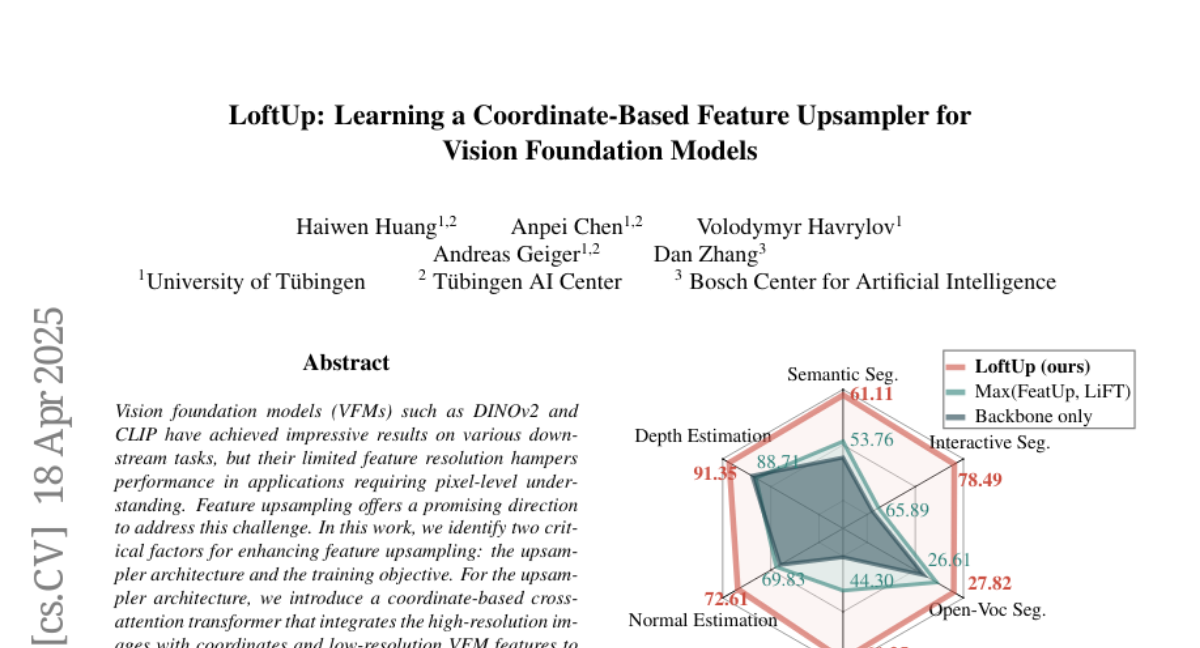
27. PROMPTEVALS: A Dataset of Assertions and Guardrails for Custom Production Large Language Model Pipelines
🔑 Keywords: LLMs, PROMPTEVALS, Assertion Criteria, Fine-tuned Mistral, Reliability
💡 Category: AI Systems and Tools
🌟 Research Objective:
– The objective is to improve the reliability of Large Language Models (LLMs) in production data processing pipelines by developing assertions or guardrails for model outputs.
🛠️ Research Methods:
– The study introduces PROMPTEVALS, a dataset significantly larger than previous ones, used to evaluate both closed- and open-source models in generating assertions, with a benchmark test on a hold-out split.
💬 Research Conclusions:
– Fine-tuned Mistral and Llama 3 models surpass GPT-4o by 20.93% in performance, demonstrating both lower latency and increased effectiveness, contributing to advancements in LLM reliability and prompt engineering.
👉 Paper link: https://huggingface.co/papers/2504.14738
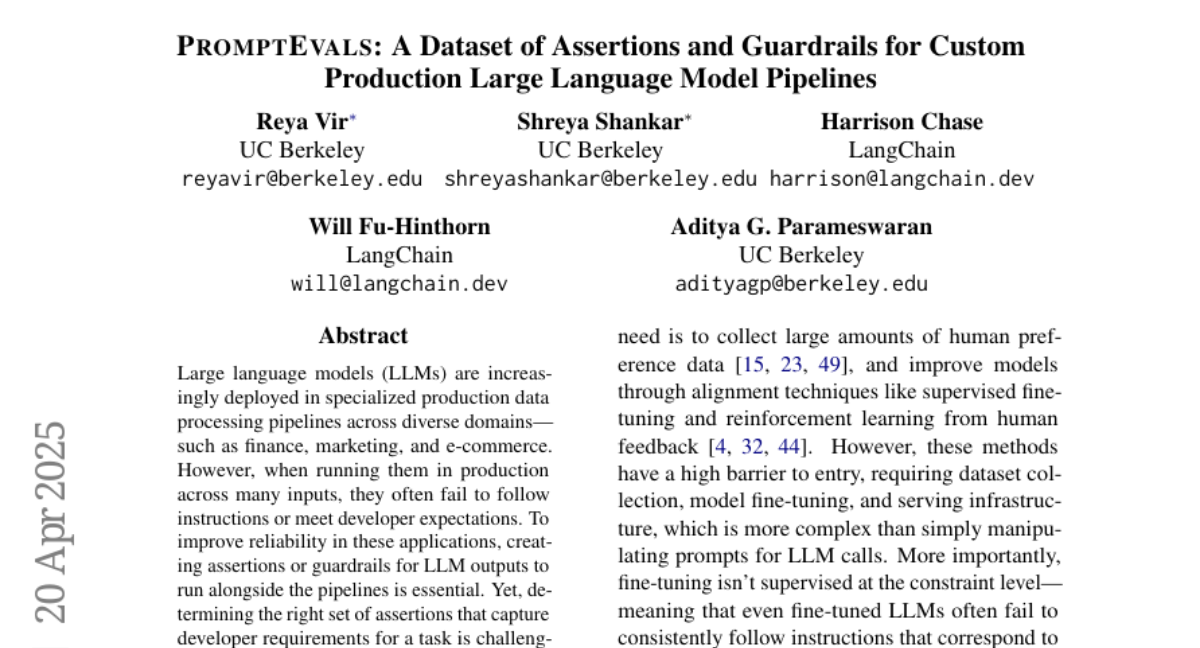
28. Roll the dice & look before you leap: Going beyond the creative limits of next-token prediction
🔑 Keywords: open-ended tasks, stochastic planning, abstract knowledge graph, next-token learning, diffusion models
💡 Category: Generative Models
🌟 Research Objective:
– The study aims to quantify the creative limits of present-day language models through minimal algorithmic tasks designed as abstractions of open-ended real-world tasks.
🛠️ Research Methods:
– Investigates the efficiency of multi-token approaches like teacherless training and diffusion models in comparison to next-token learning.
– Proposes a method called hash-conditioning to inject randomness in the input layer to maintain coherence in creativity tasks.
💬 Research Conclusions:
– Multi-token approaches are more effective in producing diverse and original outputs than next-token learning.
– Introduces a new testing environment to analyze open-ended creative skills and suggests advancements beyond softmax-based sampling.
👉 Paper link: https://huggingface.co/papers/2504.15266
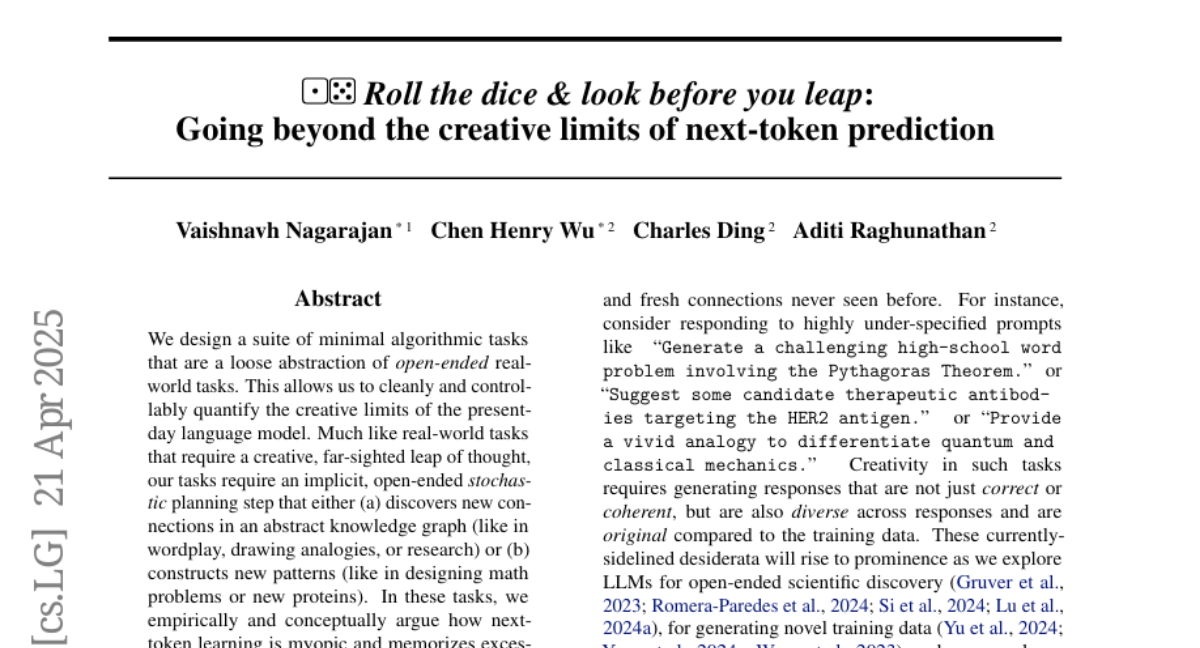
29.
